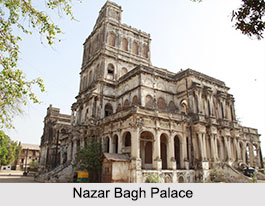 The Nazar Bagh Palace or Nazarbaug Palace is located in the West Indian state of Gujarat. More specifically, this palace is situated in the city of Vadodara at the Mandivi Gate. The Nazar Bagh was once the richest palace in Gujarat and a noteworthy palace during the British rule in India.
The Nazar Bagh Palace or Nazarbaug Palace is located in the West Indian state of Gujarat. More specifically, this palace is situated in the city of Vadodara at the Mandivi Gate. The Nazar Bagh was once the richest palace in Gujarat and a noteworthy palace during the British rule in India.
Derivation of the Name of Nazar Bagh Palace
Nazar Bagh Palace derived one half of its name (Nazar) from the saying `nazar na laage`, which is often used for someone or something beautiful. This palace had a classic look, thus inviting the above mentioned saying for itself. The palace also had beautiful garden. Garden translates into bagh in Hindi. Therefore, the other half of its name was derived from garden, thus being called the Nazar Bhag Palace.
History of Nazar Bagh Palace
Nazar Bagh Palace was constructed in the late 19th century, more specifically, 1721 AD. Malhar Rao Gaekwad is credited with the establishment of this palace. It was known to be the Gaekwad`s royal palace in the city, as the Gaekwads resided in this palace. The Gaekwads of Baroda (now Vadodara) and later the British in the 18th century brought some stability into Saurashtra and Gulf of Kutch. The monetary resources that were otherwise spent for battle and for the maintenance of the army were then used for the construction of beautiful palaces and mansions. Nazar Bagh Palace was used to organize ceremonial occasions by the Gaekwads.
Architectural Design of Nazar Bagh Palace
Nazar Bagh Palace represents the neo classical style of architecture. It is reminiscent of the European buildings present in the medieval periods in India. It is a pure white three storey building and rectangular in shape. It"s most noteworthy aspect is its step like elevation on the structure. All the three floors, including the ground floor have a high rise, leaving few spaces so as to resemble steps. Major parts of the building have been erected using crunched stones. The third floor has a small penthouse. It was constructed to bedeck the top structure. The outer front of the palace has many cylindrical pillars and corridors. The palace is also provided with private balconies, which are supported on pillars. It also has halls and living areas, which are very spacious. The halls were used to arrange royal ceremonies. Visitors will also come across a unique courtyard, which is supported on pillars. The storage rooms and the small mansion like rooms are arranged in the palace in a lane like order. The interior of the palace is bedecked with sculptures, portraits, paintings of the royal clans, wooden furniture and the art and crafts of the period. The Shish Mahal, which translates into the "Palace of Glass" is yet another noteworthy aspect of Nazar Bagh Palace in the ground.
Collection of Nazar Bagh Palace
The Nazar Bagh Palace was found to be a home to a variety of objects of great antiquity. Some of the authentic ancient items that were found to be preserved in this palace are the royal family"s heirlooms, the jewels of the Gaekwad family, a cloth embroidered with precious stones and seed pearls and the solid gold and silver guns, with each barrel weighing over 100 kg. More specifically, a diamond necklace which carried both the Star of the South diamond, weighing about 125 carats and the English Dresden were a part of the collection of the jewels of the Gaekwad family in the museum. This collection was believed to be worth $10,000,000 in the year 1927. It was to cover the tomb of Muhammad that the cloth embroidered with precious stones and seed pearls was designed.
Related Articles:
Indian Regional Monuments
Monuments of Gujarat
Monuments of Maharashtra
Monuments of Rajasthan
Monuments Of Bihar
Monuments of West Bengal
Monuments Of Kerala
Monuments of Punjab



















